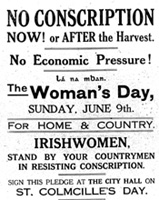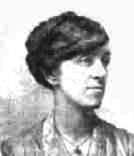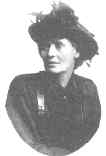1918
Meanwhile, World War I continued and when the British government announced the extension of conscription to Ireland in 1918, every kind of national group opposed it. The Catholic hierarchy protested and the Home Rule Party withdrew from the House of Commons. A nationalist one-day strike was called for 23 April and Cumann na mBan organised a day of protest for 9 June when women paraded throughout the country and signed a special pledge for women:
|
Because the enforcement of Conscription on any people without their consent is tyranny, we are resolved to resist the conscription of Irishmen.
We will not fill the places of men deprived of their work through enforced military service.
We will do all in our power to help the families of men who suffer through refusing enforced military service.
Quoted in Margaret Ward, Unmanageable revolutionaries, London, 1983, p.128. |
|
The country would grind to a halt if women refused to take the jobs of the men who were conscripted. Cumann na mBan sold flags which announced 'Women won't blackleg' and the Irish Women Workers' Union demonstrated in support.
Conscription was not in fact extended to Ireland but several republicans were subsequently arrested and lodged in English jails. Constance Markievicz was sent to the women's prison at Holloway, as were Kathleen Clarke, Maud Gonne and Hanna Sheehy Skeffington while Cumann na mBan was banned as an illegal association.
|

Detail of poster issued by Cumann na mBan in June 1918
|
Yet Cumann na mBan had 600 branches by the end of 1918. The war ended in November and a general election would soon take place in the UK which still included Ireland. The Representation of the People Act gave the vote for the first time to most women over 30 and women were also eligible for election. Cumann na mBan urged Sinn Féin to nominate women candidates and they urged women to vote for Sinn Féin:
Irishwomen, your country calls to you to do your share in restoring her to her rightful place among the nations. No great sacrifice is asked of you. You have merely to secure the votes, to which you are entitled, and use them on behalf of Sinn Féin candidates at the next general election. ...
Quoted in Maria Luddy, Women in Ireland 1800-1918, Cork, 1995, p.319. |
But Sinn Féin was almost a male preserve by now and they only nominated two women.
Winifred Carney failed in her attempt to win a seat in a Belfast constituency but Constance Markievicz was elected. She was back in prison at the time, but a massive campaign and canvass by Cumann na mBan, the Irish Women's Franchise League, and the Irish Women Workers' Union resulted in her historic success. She obtained 7,835 votes in a Dublin constituency and was the first woman ever elected to the Westminster parliament. On her release from prison, she visited the House of Commons and saw her name on a coat rack next to Edward Carson's but she never took her seat there as she was pledged to Dáil Éireann instead.

Winifred Carney |

Constance Markievicz |
Questions
- How did Cumann na mBan support the campaign of opposition to conscription in 1918?
- How did Cumann na mBan give support to Sinn Féin in 1918?
- What was the aim of the Cumann na mBan poster? Discuss the opinion that it appeals to several emotions at once.
- Suggest two or more reasons why Sinn Féin only nominated two women candidates for the 1918 general election.
Activities
- Make a poster for the Cumann na mBan anti-conscription campaign.
- Make a poster for the election of Winifred Carney or Constance Markievicz.
- Write an election speech for either Winifred Carney or Constance Markievicz.
- Make a poster urging women to join Cumann na mBan.
- Write a newspaper report with suitable headline on the election of Constance Markievicz.


